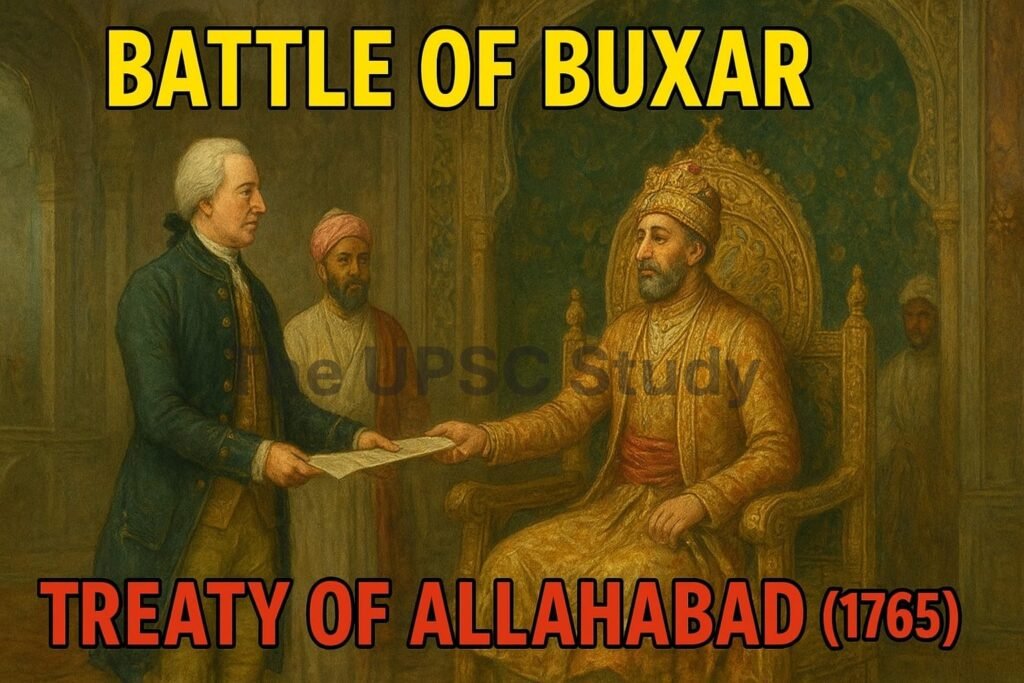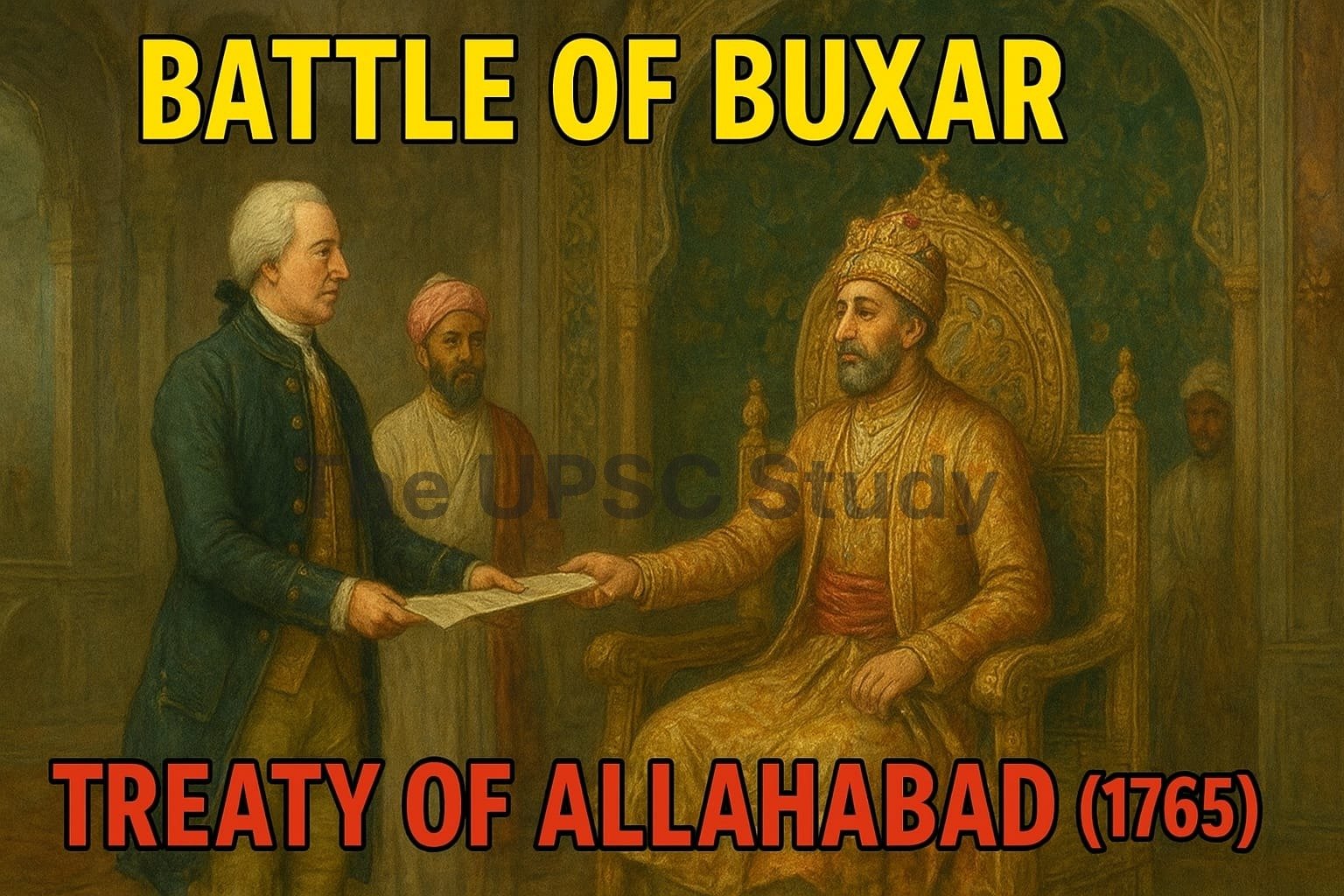The Battle of Buxar (1764): The final step to the Company’s Ascendancy in Bengal

Table of Contents
Battle of Buxar: In brief
The Battle of Buxar (1764) was a defining conflict in Indian history that marked the consolidation of British power in Bengal and beyond. It culminated in the Treaty of Allahabad (1765), which formalized the East India Company’s supremacy in revenue collection and political dominance in northern India.
Background to the Events Leading up to the Battle of Buxar
To understand the significance of the Battle of Buxar, it is essential to trace the trajectory of Bengal politics and the ambitions of the East India Company (EIC) after the Battle of Plassey (23 June 1757), fought during the Third Carnatic War. The events that unfolded between 1757 and 1764 reveal a story of betrayal, ambition, discontent, and eventual consolidation of colonial power.
Mir Jafar: A Puppet Nawab of Bengal
His Background and Character
Mir Jafar, a commander in the Bengal army under Siraj-ud-Daulah, was a man of ambition but little strategic foresight. Known for his vacillating loyalty, he was enticed by the East India Company with the promise of the throne of Bengal. His weakness of character, personal greed, and inability to inspire confidence made him an ideal puppet in the hands of the Company.
Installation after Plassey
Following Siraj-ud-Daulah’s defeat in the Battle of Plassey (1757), Robert Clive and the EIC installed Mir Jafar as the Nawab of Bengal. His accession marked the beginning of indirect British control, as the Company essentially dictated financial and administrative decisions while maintaining the façade of Mughal suzerainty.
Mir Jafar and the Battle of Chinsura (1759)
Despite being indebted to the EIC for his throne, Mir Jafar soon grew disillusioned. The Company’s unending demands for money and concessions drained Bengal’s treasury. To counterbalance British influence, Mir Jafar sought an alliance with the Dutch, who still held commercial interests in Bengal.
Course of the Battle
In November 1759, the Dutch attempted to land reinforcements at Chinsura. However, the EIC, with Clive’s strategic brilliance, preempted their moves. In the ensuing Battle of Chinsura, the combined Dutch and Nawab’s forces were defeated decisively. Mir Jafar, once again exposed in his duplicity, lost the confidence of his British patrons.
Removal of Mir Jafar
After his failure at Chinsura, Mir Jafar was dethroned by the Company. His inability to control Bengal’s finances and his weak military strategy sealed his fate. The EIC replaced him with his son-in-law, Mir Qasim, whom they believed would be more cooperative.
Mir Qasim: Ambition and Reform
His Character and Background
Mir Qasim was unlike his predecessor. Intelligent, ambitious, and a capable administrator, he harbored a vision of an independent Bengal free from Company exploitation. Initially compliant with British demands, he soon grew resentful of their high-handedness that culminated in the Battle of Buxar.
The Dispute over the Farman of 1717
A major point of contention was the misuse of the Dastak (trade permit) under the Farman (royal order) of 1717, issued by Mughal Emperor Farrukhsiyar. This decree exempted the Company from paying duties on trade in Bengal. Over time, the British not only used the privilege for themselves but also began to extend it unlawfully to their private traders, thereby undermining Bengal’s treasury and local commerce.
To counter this, Mir Qasim abolished internal trade duties altogether, granting equal rights to Indian merchants. This move enraged the Company, as it deprived them of unfair competitive advantage.
Negotiations with the Company
Mir Qasim’s attempt to revoke the misuse of Dastak (trade permit) led to tense negotiations with Robert Clive and Company representatives. The Nawab demanded the curtailing of private English trade, while the Company insisted on retaining their privileges. The stalemate escalated into open hostility.
Prelude to the Battle of Buxar
The growing tensions eventually led to military confrontation. Mir Qasim, realizing the futility of negotiations, shifted his capital to Munger and began reorganizing his army along European lines. His efforts reflected his determination to resist Company dominance.
However, the Company’s superior resources and its alliance-building capacity placed Mir Qasim in a precarious situation. To strengthen his position, he forged an alliance with Shuja-ud-Daulah, the Nawab of Oudh, and Shah Alam II, the Mughal Emperor. Their combined forces were formidable, but the Company, under Major Hector Munro, was equally prepared.
The Battle of Buxar (1764)
The Engagement
On 22 October 1764, the combined armies of Mir Qasim, Shuja-ud-Daulah, and Shah Alam II faced the East India Company at Buxar. The allied forces numbered over 40,000, while the Company had around 7,000 well-trained troops, including European soldiers and disciplined sepoys.
The battle witnessed fierce fighting. Mir Qasim’s earlier reforms ensured a disciplined start, but the lack of coordination between the allies, combined with the Company’s superior strategy, turned the tide. Shuja-ud-Daulah’s forces faltered, and Shah Alam II’s contingents lost morale. Ultimately, the Company secured a decisive victory.
The Treaty of Allahabad (1765)- The Conclusion of the Battle of Buxar
The defeat of the combined forces compelled the allies to negotiate. The Treaty of Allahabad, signed in 1765, became the cornerstone of Company authority:
- Shah Alam II granted the Diwani rights (revenue collection) of Bengal, Bihar, and Orissa to the East India Company.
- Shuja-ud-Daulah had to cede territory and pay indemnity, though he was later restored to Oudh under British influence.
- Mir Qasim, humiliated and stripped of power, fled and eventually died in obscurity.
- Mir Jafar was reinstated as Nawab, though only as a ceremonial ruler.
- The Company Officials became the de-facto “Nabobs” of Bengal where they involved in amassing wealth and in internal corruptions, whereas the native nawabs and landowners were forced to give up land under new governance.
Aftermath and Consequences of the Battle of Buxar
Impact on Mir Qasim
Mir Qasim’s ambitious reforms and defiance ended in ruin. His attempt to modernize Bengal’s military and challenge the Company’s economic exploitation failed against the disciplined forces of the EIC.
Impact on Shuja-ud-Daulah
The Nawab of Oudh faced territorial losses and financial penalties, although the British strategically allowed him to remain in power, thus creating a buffer state.
Impact on Shah Alam II
The Mughal Emperor was reduced to a mere pensioner under Company patronage, his imperial prestige now at the mercy of colonial overlords.
Re-installation of Mir Jafar
The reinstatement of Mir Jafar reflected the Company’s policy of maintaining pliant rulers who ensured British supremacy. His rule, however, was symbolic, as real authority lay with the Company.
Expansion of Company Control under Robert Clive
The Treaty of Allahabad expanded the Company’s authority immensely. With the Diwani rights, it gained direct access to Bengal’s vast revenues. Clive proclaimed himself the Governor of Bengal and introduced the system of Dual Governance, wherein the Company controlled revenue (Diwani), while the Nawab nominally retained military and judicial functions (Nizamat). This arrangement allowed the Company to exercise power without bearing administrative costs, further entrenching colonial exploitation. There was huge corruption in the internal system of the company. Clive himself was accused of amassing a sum of £ 401,102 (equivalent to £67,900,000 in current value) when he left India in 1767, which remitted through Dutch East India Company.
Conclusion
The Battle of Buxar was more than just a military engagement; it was a turning point that transformed the East India Company from a trading enterprise into a territorial power. The events that led to it—from Mir Jafar’s betrayal at Plassey to Mir Qasim’s failed resistance—highlight the interplay of personal ambition, imperial greed, and colonial strategy. The Treaty of Allahabad symbolized the decline of Indian sovereignty and the rise of Company Raj, setting the stage for nearly two centuries of British dominance in India.
Who the Battle of Buxar was fought between?
It was fought between the combined forces of Bengal Subah under Mir Qasim, Oudh (Awadh) Subah under Suja-Udd-Daulah and the Mughal Sultanate under Shah Alam II, and the force of East India Company under Hecter Monroe.
What caused the Battle of Buxar?
First, the misuse of Dastak (trade permit) under Farman (Royal order) of 1717 by the company officials who were also trading it unlawfully to their private traders.
Second, the revocation of Dastak and abolish the trade duty for all, including the native traders.
What was the consequence of the Buxar Battle?
Superiority of the Company and victory against the combined forces of Bengal Subah.
Territorial loss of Oudh.
Granting Diwani Rights (revenue rights) to Clive of the Bengal Subah by Shah Alam II followed by Dual Governance of Clive.

